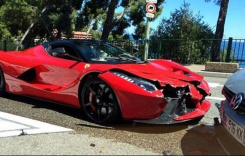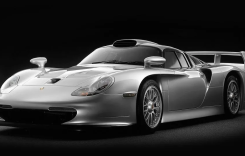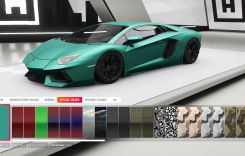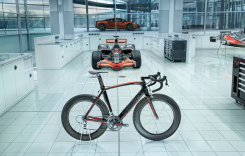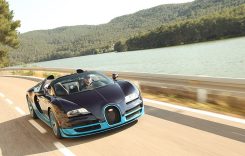Gratification is immediate, an orchestra of 40mm throttle bodies and six fuel injectors synchronized with the twists of my right wrist, the hit of torque urgent, six cylinders operating in harmony to spin the 180mm patch of Dunlop rubber behind me. The initial surge continues throughout the Valkyrie’s powerband, smooth and linear until a healthy midrange punch around 4200 rpm provides extra kick. As the road to Idyllwild, California, climbs up and through the San Jacinto Mountains, the Valkyrie’s low-slung Flat Six keeps the center of gravity down and transitions are swift and sharp through the switchbacks and sweepers. The ease at which the Valkyrie is swinging side-to-side matches the bike’s sure-footedness as we test lean angles up the mountain, the next-gen Valkyrie hustling up the grade with an ease none of its forebears could match.
Because this isn’t your dad’s Valkyrie. Yes, like the original Valkyries, the new version inherits its engine from the Gold Wing. This isn’t a bad thing when that powerplant uses six horizontally-opposed cylinders to generate a plethora of power before it hits peak torque around 4000 rpm. New three-way intake ducts on the air cleaner differentiate it from the Wing. Liquid cooling and a precise firing order means it not only delivers the goods from the get-go but does so efficiently, dual radiators keeping engine heat down and its Flat Six design making vibrations almost non-existent. Best part is, the Valkyrie’s engine has 154 pounds less mass to get in motion, and riders reap the benefits. Crack the throttle on the 2014 Honda Valkyrie and hold on tight because it will spool up and rocket off the line until first gear plateaus at 44 mph. Grab second gear just before it reaches that peak and the bike lurches forward again thanks to its low-end punch. By the time second gear begins to wind out, the Valkyrie is already above 70 mph with three gears to go. The only grievance we can air about the Valkyrie’s mill is too much of it is concealed beneath bodywork for our liking, unlike the old Valkyrie engine that was a focal point of the motorcycle’s design.

The engine isn’t the only thing the new Valkyrie shares with the Gold Wing as both are outfitted with primarily the same twin-spar aluminum frame and Pro Arm single-sided swingarm. The Valkyrie does have a different rear subframe to accommodate the seat designed for it. Up front, the Valkyrie’s 45mm fork has been lengthened and its rake angle increased 0.35-degreees. Trail on the front end has also been increased incrementally (0.2-inches) and its damping settings have been altered to adjust for the differences in weight between it and the Wing. Out back, it sources Honda’s
LED’s are used for the headlight, taillight and turn signals of the 2014 Honda Valkyrie.
The solo gauge on the ’14 Valkyrie has a digital speedo, fuel gauge, trip meters, odometer, clock, and an rpm indicator in the form of a bar running along the bottom. The speedo is easily viewable in direct sunlight.
Hidden beneath this bodywork is a powerful water-cooled, horizontally-opposed six-cylinder engine.
The 2014 Honda Gold Wing Valkyrie is available in blue metallic, black, and dark red metallic for $17,999.
Pro-Link single shock, the spring capable of being adjusted by hand for preload, the knob accessible by removing the left side cover below the seat. The suspension package does an admirable job of sheltering riders from jarring bumps while keeping the motorcycle composed even over rougher road surfaces. The spring on the rear is strong and its compression and rebound rates are dialed almost ideally. The shock resisted bottoming out even when we deliberately squared a sunken washout in the road. Granted, we did stand up and weight its pegs like an ADV bike, but the suspension still had to deal with the added weight of a 225-pound rider, the shocks keeping it poised and controlled and the frame displaying no flex.
Winding down out of the mountains, the roads straighten out as it cuts through open grasslands and scrub pines and the pace relaxes for a spell. The Valkyrie’s thickly padded seat and relaxed riding position have provided easy miles so far. The bulk of the bike is forward, its wide radiator shrouds and bodywork pushing air around riders but a fair amount creeps over the bars. The seat feels lower than its 28.8-inch seat height. Its mid-controls tuck a rider’s feet in and the bars pull back and up just enough to cant the riding position slightly forward. A peek over the bars reveals a functional digital speedo, a rectangular window with easy to read numbers and graphs. Primary is the display for speed while a bar running along the bottom of the gauge serves as an rpm indicator. A clock, odometer, fuel gauge, trip meters and a handful of indicator lights provide the basics. We were pleased to discover the speedometer is easily viewable in direct sun.
The ride on the latest interpretation of the Valkyrie is filled with typical Honda goodness, traits so familiar you almost take them for granted. From the ST1300 to the CB1000R to the Gold Wing we’ve ridden, a smooth shifting transmission and strong stopping power are a constant. The Valkyrie has dual 310mm front discs, bigger than the 296mm discs both the Wing and F6B run, accompanied by a single 316mm disc on the rear. The calipers are Nissin, four-pistons front and duals rear. At most speeds, a good squeeze of the front brake lever is all you’ll need as the front brake is where almost all the power is. Use in tandem with the rear, and you can rein a motorcycle weighing in the 750-pound range fairly quickly. The Valkyrie doesn’t have the linked braking system of the Gold Wing, and the rear unit doesn’t have the same bite or power as the front. The rear eventually grabs and with little weight over the back tire the bike will fishtail. ABS is an option, but is offered only on the black model for an extra $1000.
And while the Valkyrie was the primary focus of the recent Honda press launch, it was also a celebration of the entire flagship Flat Six line. This meant we split our riding time between the saddles of the Valkyrie and the 2014 F6B. The 90-pound difference between the two is most obvious off the line, but without the front fairing and instrument cluster weighting the front end, the Valkyrie outshines it in ease of steering as well. Without the saddlebags, the Valkyrie’s willingness to transition quicker is also apparent. The rider triangles differ slightly as well. The Valkyrie’s footpegs are 1.3-inches higher and 0.6-inches more forward than F6B. The handlebars sit different, too, the bars 1.3-inches forward and 1.5-inches taller than the F6B. The bar spread is a touch wider too by 0.7-inches.
The Valkyrie and F6B paint different profiles as well, the F6B sporting the full Gold Wing style front fairing, the Valkyrie’s chrome-trimmed headlight and open bars more cruiser oriented. In addition to its headlight, the Valkyrie uses LEDs all the way around. The back end meanwhile is Rune-like. Honda sought to give its muscle cruiser a different exhaust note than its Flat Six kin, so the slash-cut mufflers are shorter, lighter and more compact. The 6.1-gallon tank is metal while its fenders and radiator shrouds are plastic. The passenger pillion is fairly long and the bike has grab rails. The passenger pad and grab rails come off easy and a cover is provided to hide the rail mounting points. A curious side note from our day in its saddle. It was funny to hear seasoned motojournalists honking the horn throughout the afternoon by accident trying to engage the turn signals. The button for the horn is located above the turn signal switch on the left control housing and kept tripping riders up, myself included.
Ruminating about our time on the 2014 Valkyrie, one of the most poignant quips provided by the Honda PR machine is “The Valkyrie is not a tribute machine that celebrates the past.” The new platform definitely lends more sport to the equation. And while the original Valkyrie was introduced at the height of the “displacement wars” when OEMs battled to put out the biggest, baddest production cruiser on the market, its current purpose has shifted. Genre bending has gained ground as motorcycles blur the lines between sport and cruiser. Look at ADV bikes, bikes supposedly built for the dirt but equipped with some of the most sophisticated traction control and suspension packages on the market. One purpose of the 2014 Valkyrie is it completes Honda’s Flat Six line, from its top-selling luxo-tourer to a sport bagger to a road-huggin’, arm-stretchin’ cruiser. But they’re hoping the bike’s more sport-oriented disposition will appeal to a younger demographic, something the F6B hasn’t quite achieved. The motorcycle combines a powerful engine in a well-balanced chassis. It’s quick and handles well, has a slick transmission and overall is dialed tight. Based on its merits, you’d think it’s an easy sell. But the question is, even though the Valkyrie has its own battle cry, does it have a distinctive enough signature? We’ll find out on the sales floors.


